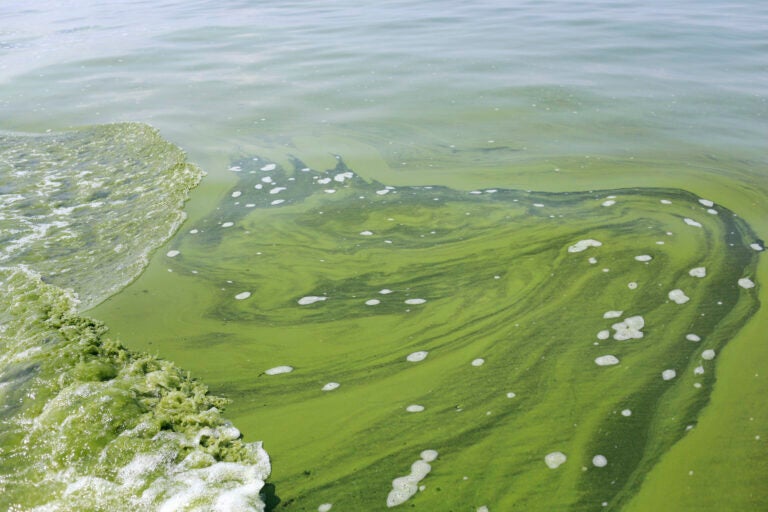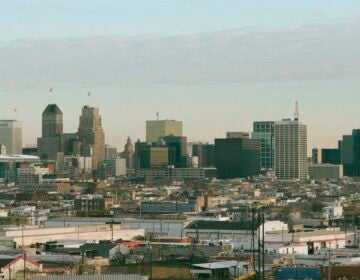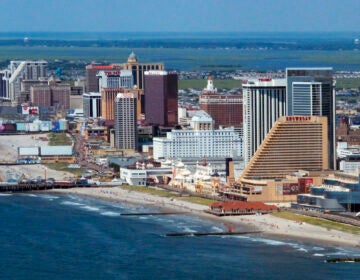Waging a $13.5 million battle against pond scum in N.J.’s lakes
In 2019, blue-green algae bloomed in freshwater lakes, and toxins affected wildlife, boating and swimming. A new initiative aims for better in summer 2020.

In this Aug. 3, 2014, file photo, an algae bloom covers Lake Erie. (AP Photo/Haraz N. Ghanbari)
Last June, the waters of New Jersey’s Lake Hopatcong were poisoned by pond scum.
At first, the bloom of blue-green algae was limited to a few near-shore areas on the water. But as summer 2019 progressed, the bloom spread across the entire lake, bringing with it a musty smell … and a perilous surprise.
The blue-green algae, also known as cyanobacteria, limited oxygen in the water and released powerful toxins into the North Jersey lake. That rendered the lake unusable for fishers, swimmers and boaters and endangered the wildlife that used it as a water source.
“Beaches closed when cyanobacteria cell counts reached 20,000 cells/mL [the state’s criteria for public health advisory warnings],” said Colleen Lyons, consultant for the Lake Hopatcong Commission, the panel created by the state that is charged with protecting the lake’s water quality and preserving its natural, scenic, historical and recreational resources. “The lake received less visitors, and businesses around the lake, including restaurants and marinas, were impacted.”
The toxic algal blooms affected freshwater lakes across New Jersey, including in and around Asbury Park. They dissipated in the fall, but the environmental and economic impact to those lakes and surrounding communities remained.
This summer, scientists say, it’ll be different.
What makes `bad’ algae bad?
Located 30 miles from the Delaware River in Morris and Sussex counties, Lake Hopatcong is New Jersey’s largest freshwater body. Starting this month, it’s also New Jersey’s testing ground for possible solutions to the problem of harmful algal bloom statewide.
To understand the prevalence of that algal bloom, it’s important to understand the difference between what scientist Fred Lubnow, of the environmental service Princeton Hydro, calls “good algae” and “bad algae.”
“The good algae are the ones that are very small, they’re the base of the aquatic food web,” Lubnow explained. “But the bad algae are the cyanobacteria, they’re the ones that have the potential to generate cyanotoxins and make the nasty scums.”
Those “bad algae” require three key factors to bloom: warmer water temperatures to stimulate their growth; still water conditions to ensure their stability; and high phosphorus concentrations to provide them with nutrients. Most algae use phosphate, the biologically available form of phosphorus, as a source of energy and food. Excessively high concentrations of phosphates can prompt dense “bad algae” growth, which both sucks oxygen out of the water — killing fish and other small organisms — and can produce potent and harmful cyanotoxins.
In 2019, above-average spring rainfall, combined with a summer of intense storms followed by still, sunny days, created a confluence of those factors for cyanobacteria to thrive in New Jersey’s freshwater lakes. The state recorded 40 harmful algal blooms last year, worrying residents and devastating the local economy; several even persisted through the mild winter. The outbreak prompted the Department of Environmental Protection to hold a series of public meetings, develop local projects to address and lessen future algal risk, and release a color-coded health alert system to inform residents which lakes are safe to swim and boat in.
Hunting down solutions, with no ‘magic bullet’
State officials announced a $13.5 million initiative last winter. The Lake Hopatcong Commission has since been given a grant of $500,000, plus $330,000 from local government and nonprofit stakeholders, to support its efforts to evaluate possible ways to prevent, reduce and/or control those blooms. This summer, it’s trying out a number of different solutions, including shoreline aeration, processed-wood absorbent material, a non-copper algaecide, floating wetland islands and a product called Phoslock.
The Phoslock solution is notable, Lubnow said, because its implementation on a 50-acre stretch of Lake Hopatcong makes it the largest-scale Phoslock treatment to occur in the northeastern U.S. so far. Developed by an Australian science agency, the clay-based treatment is distributed by boat, releasing a muddy slurry that sinks toward the lake bottom. There, it collects and suspends the phosphate, and thus keeps it from dispersing in the water.
If Phoslock turns out to be a cost-effective water treatment, the commission may consider implementing it in other areas of the lake, or using it as an algal bloom prevention treatment moving forward. It’s already being used by Princeton Hydro in other nearby areas, including multiple lakes in the Pennsylvania Poconos. Other bodies of water affected by toxic cyanobacteria in the past include Lake Mohawk in Sussex County, New Jersey, and Greenwood Lake in Orange County, New York.
The proliferation of algal blooms has become an increasingly urgent problem. Climate change prompts changing weather conditions that encourage cyanobacteria; New Jersey is one of the fastest warming states in the nation, NJ.com reports, and increasingly higher average temperatures make it easier for the blooms to thrive throughout the year. An influx of phosphorus, often caused by agricultural fertilizer and organic waste in sewage and industrial overflow, develops the cyanobacteria until it grows large enough to take over entire freshwater bodies — for example, a little over 80% of Lake Hopatcong’s phosphate load comes from stormwater and septic systems.
That’s why no water treatment solution can act as a “magic bullet,” Lubnow said. Even as his team works to mitigate algal blooms, it’s key that counties implement stormwater and septic management plans to reduce phosphorus load.
“Meanwhile, these in-lake projects for the HABs [harmful algal blooms] are sort of the short-term measures, the stop-gaps, until we can get a better handle on the nutrient load going into the lake,” Lubnow said.
Right now, he’s hopeful. While the blue-green blooms had devastatingly negative effects on the lake last year, the variety of treatment options — and their past effectiveness in other water bodies — suggest that change is possible. But there’s a lot riding on that possibility.
Ron Smith, chairman of the Lake Hopatcong Commission, agreed. “Our lake community cannot sustain another year like 2019,” he said.

Show your support for local public media
WHYY is your source for fact-based, in-depth journalism and information. As a nonprofit organization, we rely on financial support from readers like you. Please give today.







